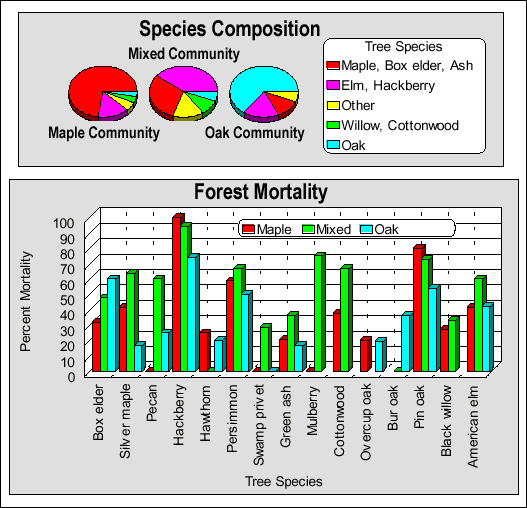|
PSR 99-01 January 1999 Forest Response to High Duration and Intensity Flooding along Pool 26 of the Upper Mississippi Riverby Robert J. Cosgriff, John C. Nelson and Yao Yin |
||
|
Many natural resource managers could not anticipate the effects
that the flood of 1993 would have on floodplain forests of the Upper
Mississippi River. Previous experience suggested that floodplain
forests were adapted to such events and should only experience removal
of upland and non-native species. However, when trees considered
highly flood tolerant did not leaf out in the spring of 1994, natural
resource managers began to realize the serious impact that a large-scale
flood could have on floodplain forest communities. To better understand
these impacts, researchers with the Long
Term Resource Monitoring Program at Pool 26 of the Upper Mississippi
River System (UMRS) began describing forest community response to
the large-scale flood of 1993. |
||
|
Flooding is the most common disturbance event on a floodplain, occurring almost annually at lower elevations. The effect of flooding on floodplain forests is not homogeneous and is largely dependent upon flood frequency, duration, intensity, timing, and stage of successional development. Most floodplain trees are adapted to survive moderate floods, however, tree species are considered susceptible to high duration and intensity flooding events, especially when these events occur during the growing season. Questions regarding forest community response following high duration and intensity events have arisen. The flood of 1993 provided an opportunity to document flood-plain forest response to a high intensity, long duration (195 days) flood that occurred during the growing season. We quantified the percent mortality of three floodplain forest community types (maple, mixed, and oak) along Pool 26 near St. Louis, Missouri. Our results (Figure 1) indicate there was a community, species and size specific response to the flood event.
Oak and maple communities responded similarly with an overall tree mortality of 42% and 41%, respectively. Mixed communities exhibited a higher mortality (60%). Among all communities, the most negatively impacted tree species were hackberry (ranging from 74% to 100%) and pin oak (ranging from 54% to 80%). Saplings suffered a higher mortality rate than trees. Maple and mixed communities lost 80% of the saplings, while oak communities lost 56% of the saplings. All saplings seemed equally susceptible, however, common persimmon, swamp privet and green ash had better survivorship than most (average mortality of 36%, 57% and 48%, respectively). |
||
|
Estimating forest successional patterns following any disturbance
event is often difficult. To accurately predict community trend,
sampling at more than one point in time is required. By examining
the tree and sapling survivorship results, we can only suggest how
forest communities might respond. The high mortality of hard- and softmast producing species (e.g., pin oak and hackberry) across all forest communities will create problems for natural resource managers who are trying to promote wildlife, particularly game animals. Much of the floodplain forests of Pool 26 are currently managed for waterfowl, turkey and whitetail deer. These species rely heavily upon acorn production for forage during the fall and winter. The loss of pin oaks and oak forests in general may have a corresponding decrease in the ability of floodplain forests to support important game species as well as other wildlife. We are currently trying to further predict forest successional trends using seedling regeneration data related to overstory canopy removal, location in regards to seed trees, soil properties, and herbaceous cover. We ultimately hope to resample the forest sites on Pool 26 and use the information in a model to better predict forest community trends following catastrophic flood events. |
||
|
This report is a product of the Long Term Resource Monitoring Program for the Upper Mississippi River System. For further information, contact Robert J. Cosgriff Yao Yin John C. Nelson Project Status Reports (PSRs) are preliminary documents whose purpose is to provide information on scientific activities. Because PSRs are only subject to internal peer review, they may not be cited. Use of trade names does not imply U.S. Government endorsement of commercial products. All Project Status Reports are accessible through the Upper Midwest Environmental Sciences Center’s website at http://umesc.usgs.gov/reports_publications/psrs/umesc_psr.html |
Page Last Modified: April 17, 2018



 We
believe that oak sites may be set back to an earlier successional
stage as silver maple, green ash trees, and green ash saplings had
better survivorship on these sites. This prediction excludes sites
dominated by overcup oak, because these sites had excellent survivorship
(19% mortality) and were relatively unaffected by the flood disturbance.
We could draw no conclusions about the mixed forest community.Even
though swamp privet, hawthorn and persimmon had the best survivorship
on these sites, they are considered understory trees and are generally
not considered forest dominants. Although the maple sites suffered
moderate mortality (example, Figure 2) in the dominant trees (42%
for silver maple and 21% for green ash), there are a large number
of dominant trees remaining and we believe that these sites will
regenerate back to maple communities.
We
believe that oak sites may be set back to an earlier successional
stage as silver maple, green ash trees, and green ash saplings had
better survivorship on these sites. This prediction excludes sites
dominated by overcup oak, because these sites had excellent survivorship
(19% mortality) and were relatively unaffected by the flood disturbance.
We could draw no conclusions about the mixed forest community.Even
though swamp privet, hawthorn and persimmon had the best survivorship
on these sites, they are considered understory trees and are generally
not considered forest dominants. Although the maple sites suffered
moderate mortality (example, Figure 2) in the dominant trees (42%
for silver maple and 21% for green ash), there are a large number
of dominant trees remaining and we believe that these sites will
regenerate back to maple communities.